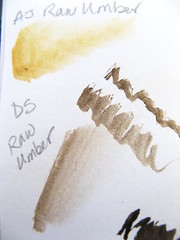
Don’t Be Fooled By A Name
04/24/2014This holds true for inks as well as paints, but don’t be fooled by a name. Manufacturers can be “liberal” with them and sometimes pay little heed to what buyers may expect. Some names are fanciful while others are deceptive. I don’t fault them when one man’s turquoise is another man’s teal.
Without question most of the inks and paints I’ve purchased have been within the anticipated range of color, but on occasion there is a divergence that is significant. Witness the watercolor swatches of paint called Raw Umber. You get the idea. Caveat emptor.

When it comes to purchasing ink, there is nothing as accurate as seeing the real deal before investing in a pricey bottle. Make a small investment in a sample or trade with a pen friend if you don’t like to gamble.
On a number of occasions, correspondence has swayed my interest in a color. A pen forum is a good place to find a like-minded aficionado with whom you can swap ink squiggles for the price of a stamp. Start or join a pen posse (club) for another way to share inky samples. Several years ago through Fountain Pen Network, I made contact with a pen person who wanted to trade bottles of ink. It turned out he lived close enough to make the trade in person.
I will tell you a little secret. I have kept all of my pen correspondence. All of it. Okay, so I’m a bit of a pack rat, but that collection amounts to a significant catalog of ink colors. Most often they are used as direct samples, but they can also be used indirectly for comparison purposes. When I read that an ink is biased in one direction and I have a sample, it is easier to imagine what the color will be. In addition those writing samples can be used to spot accuracy in online swatches whether from a website or my monitor’s loose if not fickle interpretation.
If storage space is an issue or you would like to make specific samples easier to locate, cut out a few bits of each color and glue into a notebook for future reference. Or tuck samples into envelopes by color range. There is a certain handiness to having all of the samples of a single color easy to array on my desk. Do make those swatches large enough to get a good grasp of the color.
Even a small sample is better than none so gather yours around and know better what you are buying when you order that next bottle of ink. Or don’t and be surprised. That can be fun, too.










I really liked your suggestion about sampling inks before diving in head first, along with seeing if you can get an ‘ink’ pen pal so to speak. I’ve only stuck with Private Reserve and Pelikan inks (the Pelikan purple ink is coming in the mail!) due to price, but I’ve hemmed and hawed over certain colors but haven’t been willing to commit. So this is great.
I have noticed that inks are all kinds of ranges, especially if you go to Goulet Pen Company and do ink comparisons. It’s amazing the wide range of hues just within say, turquoise.
LikeLike
Turquoise and its cousins are my favorite colors. There are so many from which to choose that it’s hard to settle on just one but a pleasure to change colors frequently. 🙂
LikeLike
As a pretty new fountain pen user, ink samples are great. They give me a chance to see how they work without investing in a big bottle. I can’t buy five full-size bottles in one go, but I can get five samples from Goulet Pens. It’s really frustrating to spend money on something only to have it not work out. Surprises can be fun in sample-sized bottles, though. 😉
LikeLike
The other thing to remember is that inks perform differently on different papers. I liked Diamine Beau Bleu on white Rhodia paper but did not on Tomoe River Paper; I like it a whole lot on the paper used in the Banditapple Carnet paper (it’s much darker).
I don’t know if you have found that to be true in your sampling and in your correspondence.
LikeLike